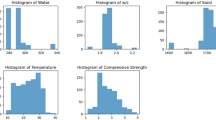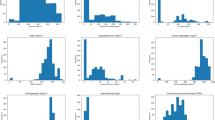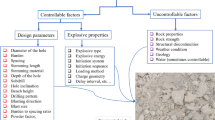Abstract
This study aims at utilizing machine learning (ML) in predicting the fire resistance and spalling degree of reinforced concrete (RC) columns with improved accuracy and reliability. A database with 119 test specimens was created for the development of ML-based regression models, and a database with 101 test specimens was created for the development of ML-based classification models. Six ML algorithms—support vector machine (SVM), random forest (RF), multilayer perceptron (MLP), extreme gradient boosting (XGBoost), adaptive boosting (AdaBoost), and light gradient boosting machine (LightGBM). The hyperparameters of the ML-based models were optimized through Bayes optimization search (BayesSearchCV) with ten-fold cross-validation. The results indicated that the AdaBoost not only accurately predicted the spalling degree of RC columns with an accuracy of 87%, but also performed best in predicting the fire resistance of RC columns with R2 = 0.96 and RMSE = 16.58. The AdaBoost model achieved high accuracy without significant bias, surpassing existing design equations. SHAP method was utilized to produce global explanations for the predictions. The results revealed that concrete compressive strength, loading ratio, slenderness ratio, and column width were the most critical features for spalling degree identification. Meanwhile, those were slenderness ratio, concrete cover, loading ratio, part of the fired column, and longitudinal reinforcement for fire resistance prediction. The parametric study demonstrated that the fire resistance of RC columns is positively affected by only concrete cover.



















Similar content being viewed by others
References
Kodur V, Raut N. (2007) Fire resistance of reinforced concrete columns – state-of-the art and research needs, ACI SP-255–5 CD-ROM: designing concrete structures for fire safety, Am. Concr. Inst. 97–124.
Du P, Yang Y, Tan KT (2022) Fire behaviour and design of hybrid fibre reinforced high-performance concrete columns subjected to uniaxial bending. Eng Struct 251:113425
Raut N, Kodur V (2011) Response of reinforced concrete columns under fire-induced biaxial bending. ACI Struct J 108(5):610–619
Kodur VKR, Cheng FP, Wang TC, Sultan MA (2003) Effect of strength and fiber reinforcement on fire resistance of high-strength concrete columns. J Struct Eng 129(2):253–259
Wu B, Xu Y (2009) Behavior of axially-and-rotationally restrained concrete columns with ‘+’-shaped cross section and subjected to fire. Fire Saf J 44(2):212–218
Tan K, Nguyen T (2013) Structural responses of reinforced concrete columns subjected to uniaxial bending and restraint at elevated temperatures. Fire Saf J 60:1–13
Rodrigues JPC, Laim LM, Korzen M (2014) Fire behaviour of circular concrete columns with restrained thermal elongation. J Adv Concr Technol 12(9):289–298
Buch SH, Sharma UK (2019) Fire resistance of eccentrically loaded reinforced concrete columns. Fire Technol 55(5):1517–1552
Lie TT (1989) Fire resistance of reinforced concrete columns: a parametric study. J Fire Prot Eng 1(4):121–129
Franssen JM, Dotreppe JC (2003) Fire tests and calculation methods for circular concrete columns. Fire Technol 39(1):89–97
Abdulraheem MS, Kadhum MM (2018) Experimental and numerical study on post-fire behaviour of concentrically loaded reinforced reactive powder concrete columns. Constr Build Mater 168:877–892
Kodur V, Mcgrath R (2003) Fire endurance of high strength concrete columns. Fire Technol 39(1):73–87
Park JE, Shin YS, Kim HS (2011) Various factors influencing on thermal behaviors of high strength concrete (HSC) columns under fire. Procedia Eng 14:427–433
Ali F, Nadjai A, Choi S (2010) Numerical and experimental investigation of the behavior of high strength concrete columns in fire. Eng Struct 32(5):1236–1243
Martins AMB, Rodrigues JPC (2010) Fire resistance of reinforced concrete columns with elastically restrained thermal elongation. Eng Struct 32(10):3330–3337
Dotreppe JC, Franssen JM, Bruls A, Baus R, Vandevelde P, Minne R, van Nieuwenburg D, Lambotte H (1997) Experimental research on the determination of the main parameters affecting the behaviour of reinforced concrete columns under fire conditions. Mag Concr Res 49(179):117–127
Shah AH, Sharma UK (2017) Fire resistance and spalling performance of confined concrete columns. Constr Build Mater 156:161–174
Kodur VKR, Raut NK, Mao XY, Khaliq W (2013) Simplified approach for evaluating residual strength of fire-exposed reinforced concrete columns. Mater Struct 46:2059–2075
AS 3600 (2009) Concrete structures. Sydney: Standards Association of Australia; 2009 - Google Search. Standards Association of Australia.
DBJ/T 15–81–2011. Code for fire resistance design of concrete structures in buildings. China Architecture& Building Press; 2011.
CEN (European committee for standardization) (2004) Eurocode 2: Design of concrete structures - Part 1–2: General rules - Structural fire design. Brussels (Belgium): EN 1992–1–2
Li S, Liew JYR (2022) Experimental and data-driven analysis on compressive strength of steel fiber reinforced high strength concrete and mortar at elevated temperature. Constr Build Mater 341:127845. https://doi.org/10.1016/j.conbuildmat.2022.127845
Alam MdS, Sultana N, Hossain SMZ (2021) Bayesian optimization algorithm based support vector regression analysis for estimation of shear capacity of FRP reinforced concrete members. Appl Soft Comput 105:107281. https://doi.org/10.1016/j.asoc.2021.107281
Nguyen DH, Truong GT, Shin M (2021) Development of extreme gradient boosting model for prediction of punching shear resistance of r/c interior slabs. Eng Struct 2351:12067. https://doi.org/10.1016/j.engstruct.2021.112067
Truong GT, Hwang H-J, Kim C-S (2022) Assessment of punching shear strength of FRP-RC slab-column connections using machine learning algorithms. Eng Struct 255:113898. https://doi.org/10.1016/j.engstruct.2022.113898
Truong GT, Choi K-K, Kim CS (2022) Implementation of boosting algorithms for prediction of punching shear strength of RC column footings. Structures 46:521–538
Truong GT, Choi K-K, Nguyen T-H, Kim CS (2023) Prediction of shear strength of RC deep beams using XGBoost regression with Bayesian optimization. Eur J Environ Civ Eng 27(14):4046–4066
Xiang C, Wang D, Pan Y, Chen A, Zhou X, Zhang Y (2022) Accelerated topology optimization design of 3D structures based on deep learning. Struct Multidiscip Optim 65(3):99. https://doi.org/10.1007/s00158-022-03194-0
Wang X, Mazumder RK, Salarieh B, Salman AM, Shafieezadeh A, Li Y (2022) Machine learning for risk and resilience assessment in structural engineering: progress and future trends. J Struct Eng. https://doi.org/10.1061/(ASCE)ST.1943-541X.0003392
Naser MZ (2020) Autonomous fire resistance evaluation. J Struct Eng 146(6):04020103
Naser MZ (2021) Observational analysis of fire-induced spalling of concrete through ensemble machine learning and surrogate modeling. J Mater Civ Eng 33(1):04020428
Naser MZ, Kodur VKR (2022) Explainable machine learning using real, synthetic and augmented fire tests to predict fire resistance and spalling of RC columns. Eng Struct 253:113824
Kodur VKR, Naser MZ (2021) Classifying bridges for the risk of fire hazard via competitive machine learning. Adv Bridge Eng 2(1):1–12
Abedi M, Naser MZ (2021) RAI: Rapid, autonomous and intelligent machine learning approach to identify fire-vulnerable bridges. Appl Soft Comput 113:107896
Vapnik V, Golowich SE, Smola A (1996) Support vector method for function approximation, regression estimation and signal processing. In: Proceedings of the 9th International Conference on Neural Information Processing Systems, NIPS’96, MIT Press, 1996, pp. 281–287.
Cevik A, Kurtoglu AE, Bilgehan M, Gulsan ME, Albegmprli HM (2015) Support vector machines in structural engineering: a review. J Civ Eng Manag 21(3):261–281
Smola AJ, Scholkopf B (2004) A tutorial on support vector regression. Stat Comput 14:199–222
Breiman L (2001) Random forests. Mach Learn 45:5–32. https://doi.org/10.1023/A:1010933404324
Li CJ, Hao H, Wang R, Li L (2020) Development and application of random forest technique for element level structural damage quantification. Struct Control Health Monotoring 28(3):e2678
Meharie MG, Shaik N (2020) Predicting highway construction costs: comparison of the performance of random forest, neural network and support vector machine models. Soft Comput Civil Eng 4(2):103–112
Gou X, Hao P (2021) Using a random forest model to predict the location of potential damage on asphalt pavement. Appl Sci 11(21):10396. https://doi.org/10.3390/app112110396
Mangalathu S, Jeon JS (2019) Stripe-based fragility analysis of multispan concrete bridge classes using machine learning techniques. Earthq Eng Struct Dynam 48(11):1238–1255
Nguyen H, Vu T, Vo TP, Thai H-T (2021) Efficient machine learning models for prediction of concrete strengths. Constr Build Mater 266:120950. https://doi.org/10.1016/j.conbuildmat.2020.120950
Nazeer S, Dutta RK (2021) Application of machine learning techniques in predicting the bearing capacity of E-shaped footing on layered sand. Soft Comput Civil Eng 5(4):74–89
Osman AIA, Ahmed AN, Chow MF, Huang YF, El-Shafie A (2021) Extreme gradient boosting (XGBoost) model to predict the groundwater levels in Selangor Malaysia. Ain Shams Eng J 12(2):1545–1556
Liang H, Jiang K, Yan TA, Chen G-H (2021) 2XGBoost: an optimal machine learning model with just structural features to discover MOF adsorbents of Xe/Kr. ACS Omega 6(13):9066–9076
Su W, Jiang F, Shi C, Wu D, Liu L, Li S, Yuan Y, Shi J (2023) An XGBoost-based knowledge tracing model. Int J Comput Intell Syst. https://doi.org/10.1007/s44196-023-00192-y
Shin Y, Kim D-W, Kim J-Y, Kang K-I, Cho M-Y, Cho H-H (2009) Appication of AdaBoost to the retaining wall method selection in construction. J Comput Civ Eng 23(3):188–192
Ding Y, Zhu H, Chen R, Li R (2022) An efficient AdaBoost algorithm with the multiple threholds classification. Appl Sci 12(12):5872. https://doi.org/10.3390/app12125872
Wang B, Wang Y, Qin K, Xia Q (2018) Detecing transportation modes based on LightGBM classifier from GPS trajectory data. In: 26th International Conference on Geoinformatics. Kunming, China, 2018, pp. 1–7, https://doi.org/10.1109/GEOINFORMATICS.2018.8557149.
Shehadeh A, Alshboul O, Al Mamlook RE, Hamedat O (2021) Machine learning models for predicting the residual value of heavy construction equipment: an evaluation of modified decision tree, LightGBM, and XGBoost regression. Autom Constr 129:103827. https://doi.org/10.1016/j.autcon.2021.103827
ISO 834–1 (1999)Fire-resistance tests-elements of building construction-Part 1: General requirements. International Organization for Standardization
ASTM (1988) Standard Test Methods For Fire Tests of Building Construction and Materials. E119–88, American Society for Testing and Materials
BSI (1987) Fire Tests on Building Materials and Structures, BS 476 (Parts 1–23), British Standards Institution, UK
KS (2019) Methods of fire resistance test for elements of buildings construction – general requirements (KS F 2257–1). Korean Institute of Technology and Standards, Seoul, Korea
Truong GT, Baek S-W, Im H, Kim C-S (2024) Fire resistance of axially loaded semi-precast composite columns. Structures 59:05697. https://doi.org/10.1016/j.istruc.2023.105697
Silva VP (2008) Fire design of reinforced concrete columns. An alternative to the tabular method presented by the Brazilian standard NBR 15200:2004. Ibracon Struct Mater J 1(4):331–392
Kodur VKR, Phan L (2007) Critical factors governing the fire performance of high strength concrete systems. Fire Saf J 42:482–488
Lie TT, Lin TD (1985) Fire performance of reinforced concrete columns. Fire Safety: Science and Engineering, American Society for Testing and materials (ASTM) STP 882:176–205
Rafik SA, Hashmi AK (2021) Review on fire resistance of reinforced concrete column. Int Res J Eng Technol 8(4):1881–1887
Buch SH, Sharma UK (2017) Fire resistance of reinforced concrete columns: A systematic review. In: Gillie & Wang (Eds), Applications of Fire Engineering. Manchester University, United Kingdom, Taylor & Francis Group, pp 141–150
Kuhlman D (2011) A Python Book: Beginning Python, Advanced Python, and Python Exercises. Platypus Global Media, pp 202
Pedregosa F, Varoquaux G, Gramfort A, Michel V, Thirion B, Grisel O, Blondel M, Prettenhofer P, Weiss R, Dubourg V, Vanderplas J, Passos A, Cournapeau D, Brucher M, Perrot M, Duchesnay E (2011) Scikit-learn: machine learning in python. J Mach Learn Res 12:2825–2830
Jones E, Oliphant T, Peterson P, et al. SciPy: open source scientific tools for Python. http://www.scipy.org/
McKinney M (2010) Data structures for statistical computing in python. In: Proceedings of the 9th Python in Science Conference. pp 56–61
Nguyen QH, Ly H-B, Ho SL, Al-Ansari N, Le HV, Tran VQ, Prakash I, Pham BT (2021) Influence of data splitting on performance of machine learning models in prediction of shear strength of soil. Math Probl Eng. https://doi.org/10.1155/2021/4832864
Hayaty M, Muthmainah S, Ghuản SM (2020) Random and synthetic over-sampling approach to revolve data imbalance in classification. Int J Artif Intell Res 4(2):86–94
Molinaro AM, Simon R, Pfeiffer RM (2005) Prediction error estimation: a comparison of resampling method. Bioinformatics 21(15):3301–3307
Liu T, Wang Z, Long Z, Zeng J, Wang J, Zhang J (2022) Direct shear strength prediction for precast concrete joints using the machine learning method. J Bridg Eng 27(5):04022026
Serega S (2015) Effect of transverse reinforcement spacing on fire resistance of high strength concrete columns. Fire Saf J 71:150–161
Author information
Authors and Affiliations
Corresponding author
Additional information
Publisher's Note
Springer Nature remains neutral with regard to jurisdictional claims in published maps and institutional affiliations.
Appendices
Appendix A
See Table A1.
Appendix B: Graphical User Interface (GUI) for ML-Based Models
Creating a user-friendly interface can promote the utilization of ML models in engineering practice by making it easier for engineers to access and use them. In this study, a standalone application program was developed for the AdaBoost-based model using Tkinter to estimate the fire resistance of RC columns. The graphical user interface (GUI) of the application is presented in Figure B1, allowing users to easily obtain the fire resistance as well as to identify spalling degree of RC columns by inputting some certain variables and clicking the Predict button. However, it is important to note that the application program is only applicable for the ranges of variables shown in Table 1, as the hyperparameters of the AdaBoost-based model were defined within these ranges. See Figure B1.
Rights and permissions
Springer Nature or its licensor (e.g. a society or other partner) holds exclusive rights to this article under a publishing agreement with the author(s) or other rightsholder(s); author self-archiving of the accepted manuscript version of this article is solely governed by the terms of such publishing agreement and applicable law.
About this article
Cite this article
Ho, T.NT., Nguyen, TP. & Truong, G.T. Concrete Spalling Identification and Fire Resistance Prediction for Fired RC Columns Using Machine Learning-Based Approaches. Fire Technol 60, 1823–1866 (2024). https://doi.org/10.1007/s10694-024-01550-8
Received:
Accepted:
Published:
Issue Date:
DOI: https://doi.org/10.1007/s10694-024-01550-8





